




Your support is critical to our success.
- Encyclopedia of CACTI
- Encyclopedia Index
- Families
- Genera
- Species
- Cactaceae
- Mammillaria
- Short Spines & Spineless
Since 4 Aug 2013

Origin and Habitat: Garden origin (Nursery produced cultivar)
Synonyms:
Mammillaria spinosissima Lem.
Cact. Aliq. Nov. Desc. 4. 1838
Synonymy: 70
- Mammillaria spinosissima Lem.
- Cactus spinosissimus (Lem.) Kuntze
- Neomammillaria spinosissima (Lem.) Britton & Rose
- Mammillaria centraliplumosa Fittkau
- Mammillaria centraliplumosa var. gracilis Repp.
- Mammillaria gasterantha Repp.
- Mammillaria haasii J.Meyran
- Mammillaria hermannii var. flavicans Salm-Dyck
- Mammillaria pitcayensis Bravo
- Mammillaria pretiosa var. cristata Hildm. ex C.F.Först.
- Mammillaria spinosissima var. auricoma f. cristata hort.
- Mammillaria spinosissima var. aurorea (Ehrenb.) Gürke
- Cactus auroreus Kuntze
- Mammillaria aurorea Ehrenb.
- Mammillaria spinosissima brunnea Salm-Dyck
- Mammillaria spinosissima f. brunnea (Salm-Dyck) Gürke
- Mammillaria spinosissima var. castaneoides (Lem.) Borg in Borg
- Mammillaria spinosissima f. cristata
- Mammillaria spinosissima var. eximia (Ehrenb.) Gürke
- Cactus eximius (Ehrenb.) Kuntze
- Mammillaria eximia Ehrenb.
- Mammillaria spinosissima f. eximia (Ehrenb.) Schelle
- Mammillaria spinosissima var. flavida Salm-Dyck
- Mammillaria spinosissima f. flavida (Salm-Dyck) Gürke
- Mammillaria spinosissima var. genuina Gürke
- Mammillaria spinosissima var. haseloffii (Ehrenb.) Gürke
- Mammillaria haseloffii Ehrenb.
- Mammillaria spinosissima var. hepatica (Ehrenb.) Labour.
- Mammillaria hepatica Ehrenb.
- Mammillaria seegeri var. gracilispina Salm-Dyck
- Mammillaria spinosissima var. herrmannii (Ehrenb.) Gürke
- Mammillaria herrmannii Ehrenb.
- Mammillaria spinosissima var. isabellina (Ehrenb.) Gürke
- Cactus isabellinus (Ehrenb.) Kuntze
- Mammillaria isabellina Ehrenb.
- Mammillaria spinosissima f. isabellina (Ehrenb.) Schelle
- Mammillaria spinosissima var. linkeana (Ehrenb.) Gürke
- Cactus linkeanus Kuntze
- Mammillaria linkeana Ehrenb.
- Mammillaria spinosissima var. mirabilis (Ehrenb.) Gürke
- Cactus mirabilis Kuntze
- Mammillaria mirabilis Ehrenb.
- Mammillaria seegeri var. mirabilis (Ehrenb.) Labour.
- Mammillaria spinosissima f. monstruosa hort.
- Mammillaria spinosissima var. polyacantha (Ehrenb.)
- Mammillaria polyacantha Ehrenb.
- Mammillaria spinosissima var. pretiosa (Ehrenb.) Scheele
- Cactus pretiosus (Ehrenb.) Kuntze
- Mammillaria pretiosa Ehrenb.
- Mammillaria spinosissima var. pruinosa (Ehrenb.) Gürke
- Mammillaria pruinosa Ehrenb.
- Mammillaria seegeri var. pruinosa (Ehrenb.) Salm-Dyck
- Mammillaria spinosissima var. pulcherrima (Ehrenb.) Gürke
- Cactus pulcherrimus (Ehrenb.) Kuntze
- Mammillaria pulcherrima Ehrenb.
- Mammillaria spinosissima f. rubens (Salm-Dyck) Gürke
- Mammillaria spinosissima rubens Salm-Dyck
- Mammillaria spinosissima f. rubrispina cristata hort.
- Mammillaria spinosissima f. rubrispina hort.
- Mammillaria spinosissima var. sanguinea (F.Haage) F.Haage in L.H.Bailey ex Brandegee
- Mammillaria sanguinea F.Haage ex Regel
- Mammillaria spinosissima var. seegeri (Ehrenb.) Gürke
- Mammillaria seegerii Ehrenb.
- Mammillaria spinosissima f. tepoztlanensis Bravo
- Mammillaria spinosissima f. typica Gürke
- Mammillaria spinosissima var. vulpina (Ehrenb.) Gürke
- Cactus vulpinus var. Kuntze (Ehrenb.) Kuntze
- Mammillaria vulpina var. Ehrenb. Ehrenb.
- Mammillaria virginis Fittkau & Kladiwa in Krainz
Mammillaria spinosissima subs. pilcayensis (Bravo) D.R.Hunt
Mammillaria Postscripts 6: 8 (1997)
Synonymy: 4
- Mammillaria spinosissima subs. pilcayensis (Bravo) D.R.Hunt
- Mammillaria pilcayensis Bravo
- Mammillaria pilcayensis var. chrysodactyla Appenz.
- Mammillaria chrysodactyla Appenz.
Mammillaria spinosissima subs. tepoxtlana D.R.Hunt
Mammillaria Postscripts 6: 8 (1997), nom. nov. (Replaced synonym: MAMMILLARIA crassior)
Synonymy: 6
- Mammillaria spinosissima subs. tepoxtlana D.R.Hunt
- Mammillaria crassior Repp.
- Mammillaria spinosissima var. auricoma (A.Dietr.) Gürke
- Cactus auricomus (A.Dietr.) Kuntze
- Mammillaria auricoma A.Dietr.
- Mammillaria spinosissima f. auricoma (A.Dietr.) Schelle
- Mammillaria spinosissima cv. Un Pico
- Mammillaria spinosissima cv. Un Pico cristata
- Mammillaria spinosissima cv. Un Pico Monstruosa
Description: This is a stable genetic mutation from a very variable spined species Mammillaria spinosissimaSN|13783]]SN|13783]], in which each areole only produces one spine, but some perfectly spineless areoles are also present.
Stem: Columnar solitary (usually) or slowly clumping, dark blue-green, rarely exceeding 30 cm tall and 10 cm in diameter. Without latex.
Tubercles: Ovate conical, four-sided basally, the axil is lightly woolly. Tubercle arrangement: 13-21
Central spine: 1 straight, 10-30(-40) mm long (occasionally 2 or 3 or even 0).
Radial spines: 0
Flowers: Purple red, 12 mm long and in diameter.
Fruits: Red or greenish.
Subspecies, varieties, forms and cultivars of plants belonging to the Mammillaria spinosissima group
 Mammillaria crassior Repp.: (subsp. tepoxtlana) Has very fine white yellow spines
Mammillaria crassior Repp.: (subsp. tepoxtlana) Has very fine white yellow spines  Mammillaria cylindrica (DC.) Don: The identity of this plant is extremely vague and unreliable. Possibly a form of Mammillaria spinosissina with few but strong brown spines?
Mammillaria cylindrica (DC.) Don: The identity of this plant is extremely vague and unreliable. Possibly a form of Mammillaria spinosissina with few but strong brown spines? Mammillaria cylindrica f. cristata hort.: Nice crestested form with white radials and dark brownish-red central spines.
Mammillaria cylindrica f. cristata hort.: Nice crestested form with white radials and dark brownish-red central spines. Mammillaria pilcayensis var. chrysodactyla Appenz.: Differs from M. spinosissima in its smaller more compact tubercles and finer spines. It grows quite tall in age and may need something to lean on. Distribution: Guerrero.
Mammillaria pilcayensis var. chrysodactyla Appenz.: Differs from M. spinosissima in its smaller more compact tubercles and finer spines. It grows quite tall in age and may need something to lean on. Distribution: Guerrero. Mammillaria spinosissima Lem.: (subsp. spinosissima) has cylindrical stems that rarely grows higher than 30 cm, dirty white spines and lacks bristles in the axils. It is very variable due to its wide area of origin. Distribution: Morelos, Guerrero, and Mexico.
Mammillaria spinosissima Lem.: (subsp. spinosissima) has cylindrical stems that rarely grows higher than 30 cm, dirty white spines and lacks bristles in the axils. It is very variable due to its wide area of origin. Distribution: Morelos, Guerrero, and Mexico.- Mammillaria spinosissima var. auricoma (A.Dietr.) Gürke: (subsp. tepoxtlana) Spines creamy white with pale orangiish to pinkish tips. Same as Mammillaria spinosissima ssp tepoxtlana??
 Mammillaria spinosissima var. auricoma f. cristata hort.: (subsp. tepoxtlana) Nice crested form with creamy spines that are pale orange-pink when young.
Mammillaria spinosissima var. auricoma f. cristata hort.: (subsp. tepoxtlana) Nice crested form with creamy spines that are pale orange-pink when young. Mammillaria spinosissima subs. pilcayensis (Bravo) D.R.Hunt: It has whiter spines, and the stems can grow up to 50 cm long/high. It might have some latex and bristles in the axils. The flowers are purple-pink. Distribution: Guerrero.
Mammillaria spinosissima subs. pilcayensis (Bravo) D.R.Hunt: It has whiter spines, and the stems can grow up to 50 cm long/high. It might have some latex and bristles in the axils. The flowers are purple-pink. Distribution: Guerrero. Mammillaria spinosissima f. rubrispina cristata hort.: Crested form. Forms tangled brain-like cushions up to 30 (or more) cm in diameter densely spined with bright coppery red spines.
Mammillaria spinosissima f. rubrispina cristata hort.: Crested form. Forms tangled brain-like cushions up to 30 (or more) cm in diameter densely spined with bright coppery red spines. Mammillaria spinosissima f. rubrispina hort.: The “rubrispina”” selection (a.k.a "Red-headed Irishman") forms nice clumps of columns, densely spined with bright coppery red spines.
Mammillaria spinosissima f. rubrispina hort.: The “rubrispina”” selection (a.k.a "Red-headed Irishman") forms nice clumps of columns, densely spined with bright coppery red spines.- Mammillaria spinosissima var. sanguinea (F.Haage) F.Haage in L.H.Bailey ex Brandegee: has a dark green cylindrical stem and long white spines, the central spines having red tips.
- Mammillaria spinosissima subs. tepoxtlana D.R.Hunt: It has yellow spines.
 Mammillaria spinosissima cv. Un Pico: This is a stable genetic mutation in which each areole only produces one spine, but some perfectly spineless areoles are also present.
Mammillaria spinosissima cv. Un Pico: This is a stable genetic mutation in which each areole only produces one spine, but some perfectly spineless areoles are also present. Mammillaria spinosissima cv. Un Pico cristata: Crested form. Forms tangled brain-like cushions up to 30 (or more) cm in diameter, each areole only produces one spine.
Mammillaria spinosissima cv. Un Pico cristata: Crested form. Forms tangled brain-like cushions up to 30 (or more) cm in diameter, each areole only produces one spine. Mammillaria spinosissima cv. Un Pico Monstruosa: Almost spineless. The monstrous form differs from the standard cv. Un Pico in having mostly spineless areoles with only few occasional spines scattered irregularly on the stem.
Mammillaria spinosissima cv. Un Pico Monstruosa: Almost spineless. The monstrous form differs from the standard cv. Un Pico in having mostly spineless areoles with only few occasional spines scattered irregularly on the stem.
Notes: This very popular plant is in cultivation in Europe since before 1991, but never formally described.
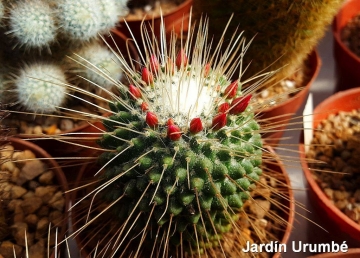
Mammillaria spinosissima cv. Un Pico Photo by: Alexander Arzberger

Mammillaria spinosissima cv. Un Pico Photo by: Xero Sicyos
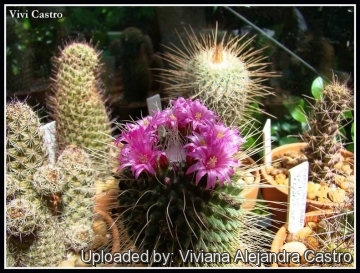
Mammillaria spinosissima cv. Un Pico Photo by: Viviana Alejandra Castro
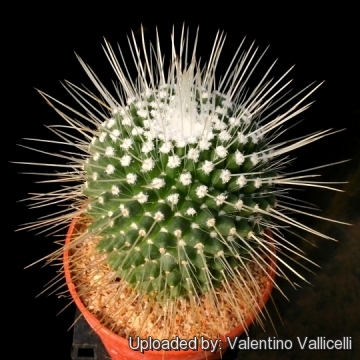
Mammillaria spinosissima cv. Un Pico Photo by: Valentino Vallicelli
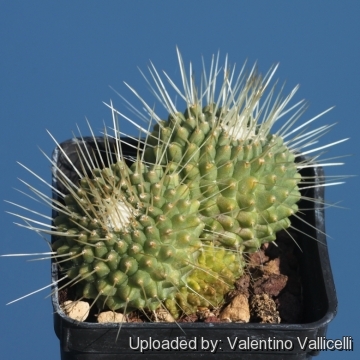
Mammillaria spinosissima cv. Un Pico Photo by: Valentino Vallicelli
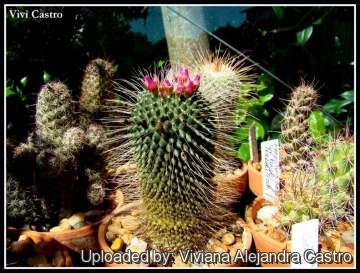
Mammillaria spinosissima cv. Un Pico Photo by: Viviana Alejandra Castro
Cultivation and Propagation: Mammillaria pilcayensisSN|11358]]SN|11358]] cv. Un Pico is an easy to grow cultivar, just as a classic cactus, don't requires any special treatment, but need as much light as possible without burning the plant to encourage the heaviest spine formation. It is a great starter plant for the cactus grower, that readily builds up into a cluster of stems highlighted by reddish spines, further decorated by rings of purple-pink blooms.
Growth rate: It is a rapidly growing species. It offset from the base and can fill a 25 cm pot in just a few years given the best conditions.
Soils: It likes very porous standard cactus mix soil with little organic matter (peat, humus).
Repotting: Repotting every 2-3 years. As it is prone to rot under-pot in a smaller container filled with very porous compost. Use pot with good drainage.
Watering: Water regularly in summer, but do not overwater (very wet-sensitively, especially in light of its succulent root system). Its roots are easily lost in pots that stay damp for any length of time. Keep dry with ample airflow in winter. In the rest period no high atmospheric humidity!! Care must be taken with watering as they tends to become swollen and untidy in growth habit if given too much water and shade.
Fertilization: During the growing season enrich the soil using a fertilizer rich in potassium and phosphorous, but poor in nitrogen, because this chemical element doesn’t help the development of succulent plants, making them too soft and full of water.
Hardiness: It is quite frost resistant if kept dry, hardy as low as -5° C (some reports give it hardy to -12°C). However some warmth throughout the year will increase the grower's success (minimum 5° to 8°C during rest season).
Exposition: Outside bright sun, filtered sunlight or afternoon shade, inside it needs bright light, and some direct sun. Subject to sunburn if exposed to direct sun for too long. Tends to bronze in strong light, which encourages flowering and heavy wool and spine production.
Uses: It is an excellent plant for container growing. It always looks good and stays small. It look fine in a cold greenhouse and frame.
Traditional uses: The white, hooked spines of this spherical cactus were used as fish hooks in its native Mexico.
Pests & diseases: It may be attractive to a variety of insects, but plants in good condition should be nearly pest-free, particularly if they are grown in a mineral potting-mix, with good exposure and ventilation. Nonetheless, there are several pests to watch for:
- Red spiders: Sensitive to red spider mite. Overhead watering is helpful in controlling mites.
- Mealy bugs: Occasionally mealy bugs they develop aerial into the new growth among the wool with disfiguring results, but the worst types develop underground on the roots and are invisible except by their effects.
- Scales: Scales are rarely a problem.
- Rot: Rot it is only a minor problem with cacti if the plants are watered and “aired” correctly. If they are not, fungicides won't help all that much.
Propagation: Direct sow after last frost or (usually) or division . Seeds germinate in 7-14 days at 21-27° C in spring, remove the glass cover gradually as the plants develops and keep ventilated, no full sun for young plants! The seedlings should not be disturbed until they are well rooted, after which they can be planted separately in small pots. Cuttings: wait until the offsets that appear at the base of old clustered specimens are 1/3 the size of the parent and then detach and plant. Cuttings will take root in a minimum temperature of 20° C (but better in hot weather). Cuttings of healthy shoots can be taken in the spring and summer. Cut the stem with a sharp, sterile knife, leave the cutting in a warm, dry place for a week or weeks (depending on how thick the cutting is) until a callus forms over the wound. Once the callus forms, the cutting may be inserted in a container filled with firmed cactus potting mix topped with a surface layer of coarse grit. They should be placed in the coarse grit only; this prevents the cut end from becoming too wet and allows the roots to penetrate the rich compost underneath. The cuttings should root in 2 to 6 weeks.
| Your Actions | |
|---|---|
| Back to Mammillaria index | |
| Back to Cactaceae index | |
 |
Back to Cacti Encyclopedia index |
Privacy stantement - Terms and conditions - How to cite - About us - Feedback - Donate



